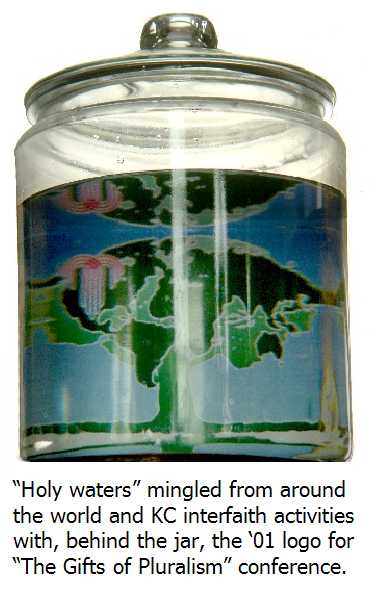
Kansas City headquarters a global water non-profit: http://water.org/ Water —
Water, used for its spiritual significance in many
faiths, has become a symbol of interfaith cooperation here, drawing on
our “City of Fountains” designation. (Kansas City is said to have more
fountains than any city in the world except Rome.)
In 2001, at Kansas City’s first interfaith conference,
“The Gifts of Pluralism,” water was collected from 14 area fountains —
from Independence to Lenexa — and 14 representatives of different faiths
poured the waters together to emphasize that our many faiths make one community.
These were added to the collection of waters of the world noted above,
just as folks from around the world have come to Kansas City and blessed
us with their traditions.
The waters thus joined were taken to Grace and Holy Trinity Cathedral where the city’s central observance was held that evening. There each Council member accepted a portion of the mingled water to take to each respective religious community. It was said, “Peoples of many faiths were killed by the terrorists. Tears are an honorable part of our response to the horrors. In our common grief, we are united. But now it is time to transform the water of tears into waters of purification, renewal and refreshment. Holy waters can extinguish the fires of hatred, wash away our self-righteousness, and well up as healing fountains of the heart.” The waters were also taken to sites around the metro area for use in other interfaith services that evening. For example, St Mark’s Catholic Church liturgist Susan Walker, with her interfaith ritual team, used the water to speak the best of America at the Community of Christ Auditorium. The fountain on the rostrum was silent until Independence Mayor Ron Stewart and Raytown Mayor Sue Frank received buckets of water being passed the entire length of the north aisle, hand to hand, by more than 50 uniformed police officers, fire fighters, emergency medical personnel and others. As the fountain filled, the water began speaking, circulating and spilling from an upper basin to the larger lower pool. With the physical act of handing off buckets, the brigade volunteers became members of each other, and those who were witnesses gazed deeper into the best of humanity, and found comfort and consolation. Something as ordinary as water, transformed by the intentions of those of many faiths in ritual reminder, can speak to us as words cannot. A simple action like handing a bucket of water to another person, deepening community, helped us face a tragedy that is unspeakable. In observing the tenth anniversary of 9/11, Grace and Holy Trinity Cathedral used the mingled waters to recognize our shared humanity and the sacred in every faith. Water as an interfaith symbol speaks of cleansing, renewal, rebirth, and refreshment. But it also recalls the countless people who found ways to respond to the tragedy, including the emergency workers. (It evokes memories of frontier America: if the barn caught fire, the entire community came out, formed a bucket brigade from the nearest water source, and did their part to put out the fire.) The waters have also been part of interfaith explorations
of students. For several years, high school students gathered at the Kauffman
Foundation for a day of encountering students from other schools and other
faiths. American Indians, Catholics, Protestants, Jews, Muslims, FreeThinkers,
and others have brought water collected from their institutions to share
with the others, and taken a vial of the mingled waters home with them
as a reminder of the shared experience of growth.
Jews may bathe in a mikvah, Christians practice
baptism, Muslims observe ablutions, the Shinto tradition includes misoge
— almost every faith has some way of using water to develop a sense
of transcendent reality. While the different ways the various faiths use
water should not be confused, water is a natural symbol of the spirit in
interfaith settings. Without water, we die.
—VERN BARNET ON HOLY WATER
Some Favorite Water Quotations Eventually, all things merge into one, and a river runs through it. The river was cut by the world’s great flood and runs over rocks from the basement of time. . . . I am haunted by waters. —Norman Maclean, A RIVER RUNS THROUGH IT You could not step twice into the same river; for other waters are ever flowing on to you. —Heraclitus And he showed me a river of water of life, clear as crystal, proceeding from the throne of God . . . . —Revelation 22:1-2 How do you preserve a drop of water? Throw it back into the ocean. —the Buddha The best is like water. Water is good; it benefits all things and does not compete with them. It dwells in [lowly] places that all disdain. This is why it is so near to Tao. —Lao-tzu The fall of dropping water wears away the stone. —Lucretius Even foul water will quench fire. —British proverb
|
|
|
headquartered in Kansas City: http://water.org/ |
